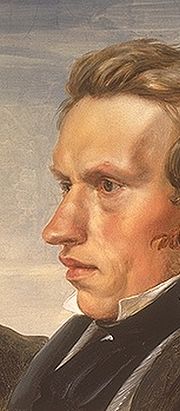
Karl Ferdinand Sohn
Encyclopedia

Germans
The Germans are a Germanic ethnic group native to Central Europe. The English term Germans has referred to the German-speaking population of the Holy Roman Empire since the Late Middle Ages....
painter of the Düsseldorf
Düsseldorf
Düsseldorf is the capital city of the German state of North Rhine-Westphalia and centre of the Rhine-Ruhr metropolitan region.Düsseldorf is an important international business and financial centre and renowned for its fashion and trade fairs. Located centrally within the European Megalopolis, the...
school.
He was born in Berlin
Berlin
Berlin is the capital city of Germany and is one of the 16 states of Germany. With a population of 3.45 million people, Berlin is Germany's largest city. It is the second most populous city proper and the seventh most populous urban area in the European Union...
and studied there under Wilhelm von Schadow
Friedrich Wilhelm Schadow
Friedrich Wilhelm Schadow was a German Romantic painter.-Biography:He was born in Berlin and was the second son of the sculptor Johann Gottfried Schadow....
, whom he followed to Düsseldorf. He treated principally mythical and poetic subjects of a highly romantic character, and painted in the mechanically idealistic manner of the Düsseldorf school. He visited Italy (1830–1831) and adopted ideas from the works of the Venetians: Titian
Titian
Tiziano Vecelli or Tiziano Vecellio Tiziano Vecelli or Tiziano Vecellio Tiziano Vecelli or Tiziano Vecellio (c. 1488/1490 – 27 August 1576 better known as Titian was an Italian painter, the most important member of the 16th-century Venetian school. He was born in Pieve di Cadore, near...
, Paolo Veronese
Paolo Veronese
Paolo Veronese was an Italian painter of the Renaissance in Venice, famous for paintings such as The Wedding at Cana and The Feast in the House of Levi...
, and Palma il Vecchio. In 1832, he was made professor
Professor
A professor is a scholarly teacher; the precise meaning of the term varies by country. Literally, professor derives from Latin as a "person who professes" being usually an expert in arts or sciences; a teacher of high rank...
in the Düsseldorf Academy
Kunstakademie Düsseldorf
The Kunstakademie Düsseldorf, formerly Staatliche Kunstakademie Düsseldorf, is the Arts Academy of the city of Düsseldorf. It is well known for having produced many famous artists, such as Joseph Beuys, Gerhard Richter, Sigmar Polke, Thomas Demand, and Andreas Gursky...
, where he exercised an important influence. Among his best-known works are:
- Lute Player (1832), National Gallery, Berlin
- Tasso and the Two Leonoras (1839)
- Rinaldo and Armida (Düsseldorf Academy)
He had two sons (Richard Sohn, born in 1834, and Karl Sohn, born in 1845) who grew up to also be painters. His nephew and pupil, Wilhelm Sohn, (1830–1899), born in Berlin, painted at first biblical subjects, and then devoted himself to genre scenes, good in characterization and drawing and of great coloristic charm. Among these are:
- Consultation at the Lawyer's (1866, Leipzig Museum)
- Warrior of the Seventeenth Century (1869, Dresden Gallery)

